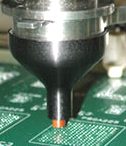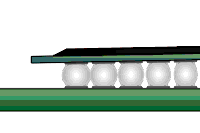Tips for Rework of Large Scale BGA Components
|
You've just been given a board with a shorted BGA site. If management decides the board is worth salvaging, there's only one thing to do; remove the BGA component, clean the site, paste the site, and replace the BGA.
You've done this many times before, but as anyone who has attempted BGA removal and replacement knows, BGA rework at any level can be finicky and challenging.
Yes, it is complicated enough, but the challenge is magnified in this case as this BGA component has 2600 balls at a 1.0 mm pitch.
You're no quitter, so you plow ahead. Removal of the component is delicate but routine for an experienced pro. You get that done with a little cautious foresight and plenty of monitoring thermocouples under and around the site.

|
|
|
Figure 1: BGA site vacuum system.
|
Next, you find that clearing the site of excess solder is a little more delicate, and you decide to use your BGA rework machine's installed vacuum solder removal system. (See Figure 1).
So far, so good, but next comes the solder paste application at this site. Even after you've chosen solder paste with the best possible slump characteristics, you begin to confront another challenge.
Proper solder paste application, an acquired skill, even for low pin counts, is crucial for successful BGA rework, and the more pins there are, the more chances there are for uneven paste deposition.
With a metal stencil, you get one pass; if you try for a second or third, you risk pumping excess paste between the stencil apertures. This can cause paste bridging and, ultimately, a solder short, which is what you were trying to correct in the first place.
If, in the effort to prevent shorts, you under-paste several pads on this very large site, it's not inconceivable that you could induce opens under the component. Something as simple as whether or not there is enough room to tape the stencil to the board securely can become an issue. There is no substitute for skill and experience in performing a proper solder paste deposit.

|
|
|
Figure 2: Edge balls shorting when BGA component "potato-chips" during rework.
|
There is no board available to complete a proper profile, so you must work your magic with an existing profile. On top of that, you decide to be extra careful and place five digital thermocouples under and around the component (getting a few into bottom vias that connect directly to topside BGA pads) so you can properly track the critical temperatures during the process.
Additionally, you place high-temperature spacers under the four corners of the component to prevent shorting due to uneven column collapse or "potato-chipping" at the corners. (See Figure 2).
Well, you can't hold your breath for an entire BGA reflow cycle, but neither can you breathe easy until the component is properly reflowed and passes an x-ray inspection. But your hard work, preparation, and care pay off in a successfully reworked site.
Congrats.
Several members of the Circuit Technology Center team contributed to this feature story.
|
|
|
|
|